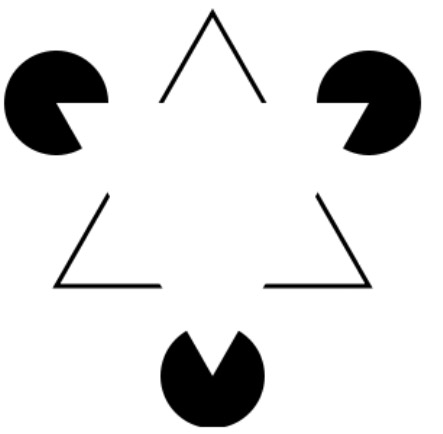#8. Test your Brain with these 10 Optical Illusions
ANSWERS AND EXPLANATIONS
Contrast your answers with the ones below, and learn about what was going on in your brain while you experienced each of these illusions:
1. Can you put the fish in the fishbowl?
Did you see a fish of a different color in the bowl? You have just experienced an afterimage. In the retina of your eyes, there are three types of color receptors (cones) that are most sensitive to either red, blue or green. When you stare at a particular color for too long, these receptors get “fatigued.” When you then look at a different background, the receptors that are tired do not work as well. Therefore, the information from all of the different color receptors is not in balance. This will create the color “afterimages.”
2. Bezold effect
The smaller squares inside the blue and yellow squares are all the same color. They seem different (magenta and orange) because a color is perceived differently depending on its relation to adjacent colors (here blue or yellow depending on the outer square)..
3. Café Wall Illusion
The horizontal lines are straight, even though they do not seem straight. In this illusion, the vertical zigzag patterns disrupt our horizontal perception.
4. Illusory Motion
The circles do appear to be moving even though they are static. This is due to the cognitive effects of interacting color contrasts and shape position.
5. How many legs does this elephant have?
Tricky, isn’t it?! This picture is an impossible picture that also contains some subjective contours, such as the Kanizsa Triangle below: A white triangle (pointing down) can be seen in this figure even though no triangle is actually drawn. This effect is known as a subjective or illusory contour. The contour of the triangle is created by the shapes around it.
 .
.
6. The Mueller-Lyer Illusion
The two horizontal lines are of the same length, even though the one at the bottom seems longer. As you know, the visual angle gets smaller with distance, so the brain automatically perceives objects at farther distances to be bigger.
In general, lines that have inward flaps, such as corner of a building, are relatively the nearest points of the overall object. Similarly, lines with outward flaps are found at the longer distance, as the farthest corner of a room. So in the Mueller-Lyer illusion, the brain perceives the line with outward flaps to be at a farther point as compared to the line with inward flaps. Consequently, the brain perceives the line with outward flaps to be longer..
7. Hermann grid illusion
There are not gray dots in this grid. However “ghostlike” gray blobs are perceived at the intersections of the white lines. The gray dots disappear when looking directly at an intersection. This illusion can be explained by a neural process happening in the visual system called lateral inhibition (the capacity of an active neuron to reduce the activity of its neighbors)..
8. The Ebbinghaus Illusion
The two orange circles are exactly the same size,even though the one on the left seems smaller. This size distortion may be caused by the size of the surrounding circles or by their distance to the center circle..
9. Does Lincoln’s face look normal?
It seems normal but now, look at it upright: Lincoln’s eyes do not look quite right!
Some neurons in the brain seem specialized in processing faces. Faces are usually seen upright. When presented upside down, the brain no longer recognizes a picture of a face as a face but rather as an object. Neurons processing objects are different from those processing faces and not as specialized. As a consequence these neurons do not respond to face distortions as well. This explains why we miss the weird eyes when the face is inverted..
10. Can you see a baby?
Another great example of an illusory contour! The baby’s head is on the left, the baby’s feet are against the trunk of the tree on the right..
I hope you had fun and learned interesting facts about your brain!
Next in SharpBrains’ top 25 brain teasers series:
- #9. What do you see?




Most of these are old, but some I haven’t seen before. I absolutely love optical illusions.
Awesome! I like being tricked even when I know its happening. Too cool.
Old salsa.
These are pretty neat!!! I am always so fascinated by optical illusions!!
WHAT ARE WE SUPPOSE TO SEE IN M.C. ESCHER ILLUSION?
I KNOW WHAT I SEE BUT.…
Hi T.H., There is nothing special to be seen in Escher’s drawing. It is a great example of an impossible object, just for your eyes’ pleasure!
coolio